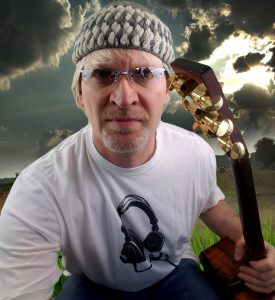Last week I had a visit from my good friend Chester. He’s a very gifted writer of country songs, and we’ve been recording some of them and slowly working towards his first solo release.
During our conversation he surprised me by saying that, guess what – he’s been deaf in his left ear since childhood!
Light bulb moment. So that’s why he always struggles with intonation sometimes when we’re recording his material.
I’m sure to be giving him a decidedly different headphone mix from now on!

I decided to talk about the best hearing protection for musicians not only because Chester reminded me of how it can greatly affect us in the studio, but also because the topic isn’t covered that often, yet it greatly affects how (and even IF) we use every bit of music gear at our disposal.
In fact, we could say there is no more crucial tool. Many of us take our daily hearing for granted, but staying cognizant of its fragility, and our responsibility to protect it, is important. If we don’t, we might not be able to maintain musicianship long into our future, and that would just plain… suck!
Let’s uncover what’s really going on beneath that awesomely coiffed hair on the side of our heads, shall we?!
Jus’ d’ Facts, Jack!
If the question “Do you use aural protection?” only conjures up for you romantic interludes with preferred backstage groupies, let us draw back the curtain for you now about why aural protection is no laughing matter:

According to the Hearing Loss Association of America, 1 out of 5 Americans suffer from hearing loss. Once you get to the 65-year-old mark, that figure increases to 1 in 3!
What’s interesting (and should really set us to changing our ways if we tend to sound extremes) is that 60 percent of the people with hearing loss get that hearing loss from where they work, or go to school.
Now, if that’s true based on your average job around the nation, how susceptible do you think we musicians are, knowing that, where we work, most of the time it’s… well, pretty loud!
It’s not just the decibel level we should concern ourselves with, however. EXPOSURE TIME is the other biggest factor. For each level of noise pollution, there is an accompanying limit to how long you can subject yourself to noise before harm kicks your ear cilia outta commission.
In other words, on-going, long-term exposure to noise can result in permanent, incurable damage to our hearing.
As of right now, there is no method of regenerating damaged Cochlear hair cells. There is promising research towards that end, but it’s at least a couple decades away from becoming a reality.
That leaves us with the cold reality that blasting our ear drums will result in debilitating damage that we’ll never recover from.
Check out these many ways we play with aural fire…
Outdoor noise
So, outside. We all like a nice, quiet, idyllic country scene, right? Birds gently singing, a nice breeze, the sussurus of a small passing stream…
Trouble is… that’s not outdoor life for most of us!

At least for those of us that live in cities, there is rarely a lack of noise pollution a stone’s throw away.
One of the biggest offenders, by far, to our ears, are the multiplicity of those ol’ trusty LAWN MOWERS. Did you know that the noise of gas lawn mowers clocks in from around 87 decibels up to 107 decibels or so?? That’s LOUD, man!
Do you mow your lawn? If so, do you wear noise-cancelling headphones when you do it?? If not, you are tearing down, a little more each time, your long-term hearing potential.
If you’re also a musician who just happens to work a lawn mowing and gardening gig as your day job, you could be at SERIOUS, IMMENENT risk of hearing damage if you’re not donning protective headphones while you work. Those consistent, high decible levels you’re near will attack your inner ear hairs BIG TIME, burn ’em to a crisp, and leave you asking “Huh?” way too often!
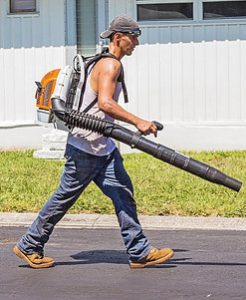
Our garages and sheds are usually chock full of other things that are not only loud, but damaging to our hearing after just a couple hours of exposure. Here is “the naughty list” you should protect your ears against:
- Leaf Blowers
- Saws
- Weed Wackers
- Air Compressors
- Snow Blowers
And how ’bout transportation? If you’re in a big city and they have one, you might occasionally ride the SUBWAY. Get this: the average noise level at a subway stop is 88 decibels. Between the train noise and the people noise (including those of us busking on our instruments by the walls or pillars!), it’s no wonder it reaches those heights of ear assault.
Here are other TRANSPORTATION MODES that tend to be pretty noisy:
- Trains
- Tractors
- Construction Vehicles
- Planes
- Motorcycles

Did you know that a plane taking off produces 140 decibels of noise?!! Wow. Glad they have that noise-cancelling material in those walls – when we’re taking off we need it!
But think of those who live near an airport. Especially a busy one, like J.F.K. or L.A.X. Think noise pollution is an issue if huge jet airliners are passing right over your roof every few minutes?!! You bet it is.
If any of these auditory terrors show up around you, do yourself a favor: put your earplugs in.
For those of you that live in Houston, Texas, congratulations… you’re surrounded by the most noise in America, according to THIS ARTICLE.
Durham, North Carolina?? Not so much. 😉

Lastly, I’d be remiss if I didn’t mention an environment that can sometimes actually exceed 140 decibels of noise and yet hardly anyone thinks to wear ear protection around it… I’m talking about… SPORTS GAMES.
Joining the fans in the stands has always been a noisy affair. Few realize, however, the extent to which their hearing is compromised while rooting for their favorite team.
Crowd noise has been measured many times, so we know with accuracy ear plugs are beneficial. For example, in 2014, at a Kansas City Chiefs game, the roar of the crowd was measured at 142.2 dBA!
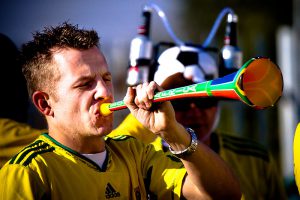
Indoor stadiums tend to be worse because of the architecture which, in some cases, traps and reverberates sound to a higher degree. Husky Stadium in Washington, for example, is known as one of the loudest stadiums in the U.S. It has a cantilevered metal roof which traps sound easily. A sound level of 133.6 dBA was measured there!
And, as if things couldn’t get worse, the South African soccer fans decided to add their own brand of musical instrument to the mix! Ever heard of the Vuvuzela?? It’s the plastic horn that has found its way into soccer games now. It only produces one note, but MAN… what a note – try 120 decibels worth of musical cheering.
Indoor noise
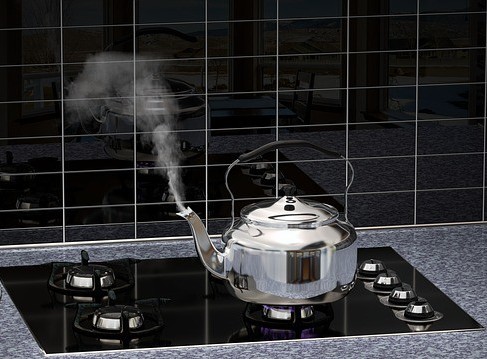
But wait – it’s not only outdoor noise pollution that can put our ears in jeopardy. Do you ever have too-high decibels sounding forth from these sources in your home??:
- Vacuum sweeper
- Music devices
- television
- Computer speakers
- generators
- air conditioners
- Food blender
- Loud family members!
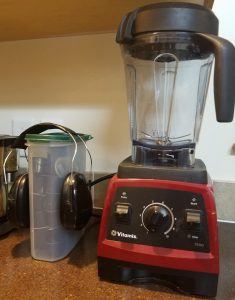
Almost every morning I start my day by making a fresh fruit smoothie for my wife and I in our Vitamix blender . In fact, I’m sipping on this morning’s right now as I write this to you. The Vitamix is great, and it has lasted us for almost a decade now.
Problem is… it’s LOUD!
But, as usual, there’s an easy fix… I just wear headphones while I’m blending! I grabbed a pair of drum headphones from one of my kits and keep them right next to the blender. Problem solved.
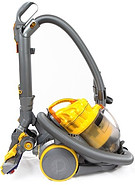
Same goes for our vacuum. It can get up to 77 decibels, and tho’ science says that will only cause damage when subjected to around 8 hours of it, I’d rather play it safe and keep my most important pro audio devices protected from even moderately-loud emanations.
If you make your living with your ears, isn’t that the least you can do?
Studio Session Assaults!
There have been sessions, especially with certain drummers I know, where I have been absolutely floored by the amount of mix they want in their headsets. I can see where my level is set at (let’s say 10 o’clock), so when a musician says it’s okay a LOT higher (say, 3 o’clock!) I know there’s some extreme hearing damage that’s already taken place.
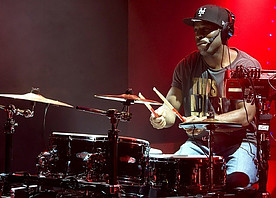
And I certainly don’t want to make it worse! But, at the end of the session, they will have only delivered the goods if they were able to hear the mix, and themselves, well. Sometimes that means cranking it for the already hearing-impaired, unfortunately.
By far the main culprits are drummers, and the reasons are obvious. But having played drums myself for years, I know that there are ways to keep the decibels from overruning into unsafe territories. We just have to know what the safe parameters are, and keep monitoring levels to maintain a best defense. By doing this, we can avoid the sound land mines that can blow up our long-term hearing faculties.
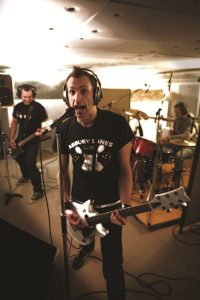
Electric guitarists are probably the next guilty of wanting it LOUD. I’m one too, so I know the temptation. One of my favorite ways to express myself through the electric is through strategic feedback. That only happens when the amp levels are somewhat loud, so ear damage is definitely a danger there if your headphones are not noise-cancelling, or if they’re (worse!) not on your head!!
There’s another adverse condition that puts our ears in potential peril: tracking a full band live, simultaneously. It’s always a good idea to talk about levels before tracking and mention to all the players decibel level dangers. Then they can make their own best decisions.
If the band wants to track in the same room together – that’s the worst for volume control, not to mention bleed-through. Still, if that’s what the client wants, we must ultimately oblige them. Be up front, though, about the risks and hazards of boosting things too hot. It might just keep your clients from walking out with hearing damage along with their finished mix.
Live Music noise
Okay, so… we all know that concerts can be loud. In our line of work, in fact, these awesome expressions of our art CAN BE the most detrimental series of assaults on our ability to hear.
As proof of that, let’s look at some scientifically gathered numbers. These noise assessments were gathered specifically at and around live concert events. Here is a table showing what they found concerning the amount of sound musicians at outdoor gigs are being barraged with:
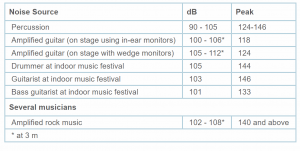
And lest we only think of ourselves, let’s take a moment to see what the music we are performing is doing to others all around us. Here is a data roster showing the typical decibel exposure taken in by outdoor concert peripheral workers, those who make the experience of coming to see us a pleasant one:
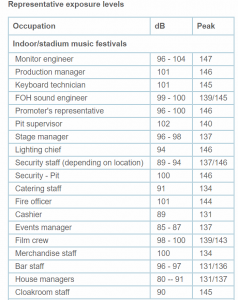
Surprised?? It’s facts like this that we need to arm ourselves with as we go forth to our gigs. Good science doesn’t lie, folks.
Remember, decibel level + duration = the level of danger.
So, based on the numbers above, if you think your rehearsal, recording or concert set-up is making you susceptible to hearing loss, do something about it! Use some aural barriers… before it’s too late.
Ears Slapped? Get an App!
Okay, so now we know all the ways our hearing is attacked wherever we go. Should you then throw in the towel on our music goals and pursuits?? Of course not. Rather, just use simple, cost-effective methods to reduce your exposure to harmful volumes.
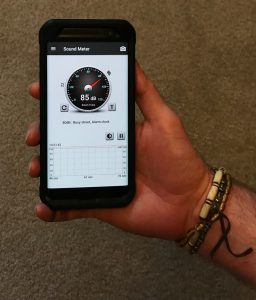
Here’s one – your cell phone!
The Internet and the cell phone really haven’t been around for that long, but they’ve revolutionized our lives to HUGE extents. I, for one (obviously) spend a lot of time using the Web and learning endlessly about so many things.
One way I use my cell phone, besides consulting the Internet, is specifically for hearing protection: I have a DECIBEL METER APP on my phone. I got it free, and it works great.
Whenever I sense that the audio volume around me is getting pretty high, out comes my trusty phone and meter, and BOOM… I am immediately shown whether I, and the company I’m in, are in danger of hearing loss or not. It’s reassuring to be able to scientifically deduce my aural environment at a moment’s notice, no matter where I’m at, rather than guess at it.
If you don’t have a decibel meter on your cell, download one RIGHT NOW. Are there options? Well, I just searched in my app store for ‘decibel meter”, and guess how many apps came up??
OVER ONE HUNDRED!!
So, you’ll have no problem finding one. Trust me, you will not be sorry having this at your disposal, and, once you use it, I bet you’ll be surprised at just how noisy normal, daily life can be.
No Smacks While You Relax!

Private music listening through headphones is at an all time high. Whether it’s the ubiquitous little ear buds that Apple made famous, or the cover-your-ear type that gamers wear to stay “in the zone”, headphones are everywhere.
So too is their ability to smack our hearing as hard as Muhammed Ali in the ring! THIS VIDEO shows you what I mean.
Did you catch that part in the video that said if you have your headphones turned all the way up, you’re probably listening at about 120 decibels?? At that extreme loudness, you only have seconds before your ear starts to fry!
One good way of testing whether your phones are too loud is this: have someone stand three feet from you and try to have a normal conversation. If you find yourself straining to hear them, then your volume is probably at a dangerous level.
Your best bet? Don’t allow yourself to turn the volume up through headphones more than HALFWAY. If you keep with that safety precaution, you’ll eliminate the chance of long-term damage to your ears.
Sick & Tired of… Ear Fatigue!
Audio studio professionals have bandied the term “Ear Fatigue” around for decades. It’s actually not a clinically accepted term in the medical community, yet the reality of it has been proven time and again to be true.
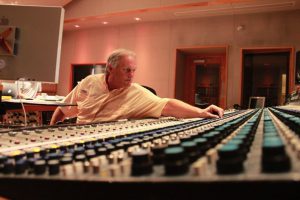
Is it the same as hearing loss??
Not necesarily, though they’re both talking about the same thing: a prolonged assault on our sensitive hearing mechanisms.
Ear fatigue, simply put, is when you have temporary hearing loss at certain frequencies, as opposed to permanent hearing loss, which is when it’s “game over, man; game over!”.
Ear Fatigue usually occurs after hours of mixing at moderately high to high SPLs. The typical frequencies that are most impacted are 4–6 kHz., since that’s where our inner ear cochlea is most sensitive to noise damage.
You know when you’ve had Ear Fatigue this way: you come back to a mix and say, “What the #$$% ??!! That sounds horrible!!” Too long under the barrage of high SPLs will cause you to not make good audio decisions, and you’ll definitely hear it the next time you push play.
Solution?? Easy – every two hours get up, walk about, take a break, then come back to it. Fresh ears will build a fresh mix. And don’t mix at high volumes all the time. You’re just asking for trouble if you do that.
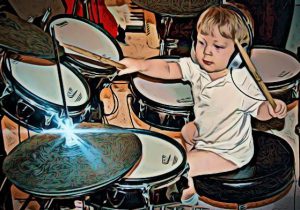
Stop the Ear-gression! Use These!!
As you can see from the picture on the right, I have taught my son to play drums always wearing ear protection. He’s done this since he started, at three, so by now I suspect if he ever did try to play without any he’d just FREAK and put ’em back on!
I’m the same way. Not only with drums, but also with electric guitars. Both can explode extremely high decibels into our senses, so attenuating those levels down to something safe is, at least in my studio, mandatory.
We have many pairs of good, noise cancelling headphones in my studio. Here are the types I use and suggest for ongoing studio work
- Noise cancelling headphones, no cable, for simple practicing. I prefer cans that reduce levels by at least 15 dB when I’m playing drums, but you can find many different pairs with varying dB attenuations. My favorite pair are the Walker EXT headphones. They’re really comfortable, and with a NRR of 34, there is no danger of hearing loss at all with these puppies!
- Noise cancelling headphones, with cable, for practicing to recorded music. I’ve got so many of these type strewn across the studio. They come in really handy when a band is tracking in the same room. I’ve got 2 or 3 pair of the Vic Firth Isolation headphones, since they deliver excellent audio, but lately I’ve come to be a fan of the Koss QZ-99 phones. They’re a lot cheaper than the Firth’s, have a cord two feet longer, and have the added benefit of having a volume knob on the headphones themselves. Always good when the talent can do something for themselves instead of asking ME! lol
- Closed-back mixing headphones, for eliminating all surrounding noise. During a mix, I always check things with headphones, so a good pair that’s comfortable can make the process a lot more pleasant. I also use these type for laying down vocals. I can hear the mix fine but there’s no bleed into the mic to worry about later. Although I used Sony MDR7506s for decades, my new favorites are the Samson SR950s. They bleed less, are more comfortable and let me hear what I need to with faithful fidelity. A sound choice, indeed!
For more headphone options, check out my article on the best for this year by CLICKING HERE.
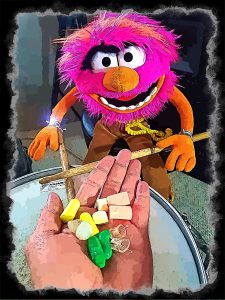
On the other hand, if you find yourself playing LIVE concert stages more than in the studio, then you’ll want one of these two devices:
- A decent, dependable pair of in-ear monitors. Best solution by far.
- Or sound-reducing ear plugs made for musicians, if you’re using floor monitors.
I played bass in a band once that had a drummer who played SO FREAKIN’ LOUD all the time, I could hardly hear my floor monitor. He hit his cymbals like Thor hits enemies with his hammer, and my ears were feelin’ about that kind of attack!!
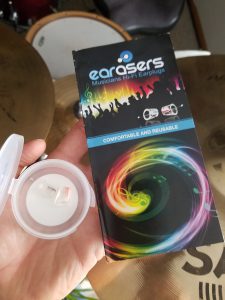
I very soon purchased some good protection in the form of “Earasers“, which are flat frequency response earplugs designed for musicians. They reduce sound by 19 dB, so when I stood next to aforementioned drummer with them in my ears, I no longer felt like the cilia hairs in my inner ear were being disintegrated by a mosquito zapper!
The other BIG plus to these which I really appreciate is that when I went to SING while wearing them, I didn’t have any intonation issues. This is a huge asset, because so many times when I’ve attempted headphones, headsets, ear plugs or ear buds… it messes with my ability to hear myself clearly and thus affects my intonation.
In any situation where you’re not wearing in-ear monitors and music is being played around you, coming from either amps or monitors, these will do a GREAT job of cutting the volume but not sounding muffled or changing the EQ of the sound. They made my rehearsals with one of my bands muuuuuch more enjoyable!
Now Go Forth and… Attenuate!!
If you’d like even more insight into why protecting our most valuable pro audio asset can be accomplished, visit our friends over at “Sound Advice” at THEIR WEBSITE HERE. This group of caring scientists specializes in teaching the entertainment world how to specifically keep our ‘sound gates’ protected. They have amassed tons of data and use all their measurements to further equip us to keep our aural senses safe.
In short, they ROCK! Thanks, guys!
If you remember nothing else from this post, take this with you: the magic number is 83 dB. If you keep audio levels at, or below, this mark, you’re pretty much guaranteed to safeguard your hearing, and keep your career intact. How do you do that? Check your decibel levels, everywhere and often.
If you MUST make yourself vulnerable to higher decibels, then make sure the DURATION is short enough to avoid damage. To gauge that, copy this chart and keep it with you, in your gear case, or on your phone:
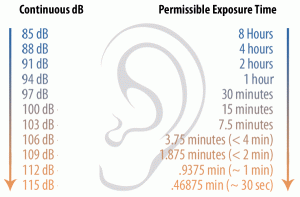
How about you? Do you protect your ears? Do you think about it only in concerts, or in everyday life as well? Or perhaps you’ve never used aural protection and think “I’m fine!”?
Whatever your position, share it with us. This post is an especially good prompt for discussion about this important, career-affecting topic.
Look forward to hearing your thoughts. ‘Til then, go… make… (quieter) sounds!!
Teaj
